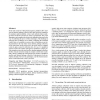357 search results - page 36 / 72 » Optimizing programs with intended semantics |
ICFP
2012
ACM
11 years 10 months ago
2012
ACM
In the static analysis of functional programs, pushdown flow analabstract garbage collection skirt just inside the boundaries of soundness and decidability. Alone, each method re...
VEE
2009
ACM
14 years 2 months ago
2009
ACM
r of high-level languages lies in their abstraction over hardware and software complexity, leading to greater security, better reliability, and lower development costs. However, o...
EMNLP
2009
13 years 5 months ago
2009
Unknown lexical items present a major obstacle to the development of broadcoverage semantic role labeling systems. We address this problem with a semisupervised learning approach ...
ESOP
1999
Springer
13 years 12 months ago
1999
Springer
Safety of interoperation of program fragments written in different safe languages may fail when the languages have different systems of computational effects: an exception raised b...
ESWS
2011
Springer
12 years 11 months ago
2011
Springer
The emergence of the Semantic Web has led to the creation of large semantic knowledge bases, often in the form of RDF databases. Improving the performance of RDF databases necessit...

